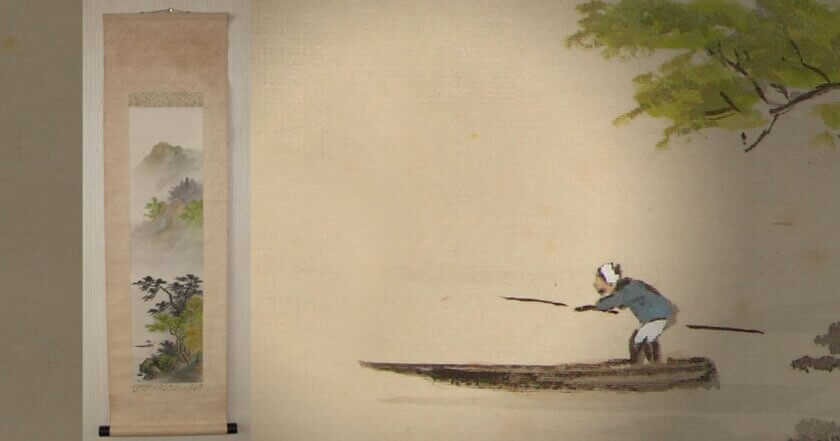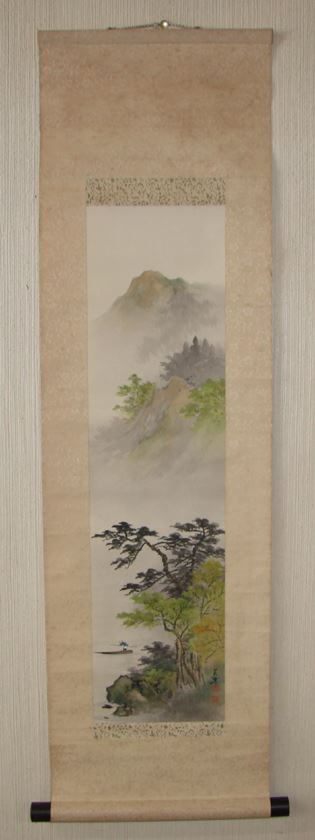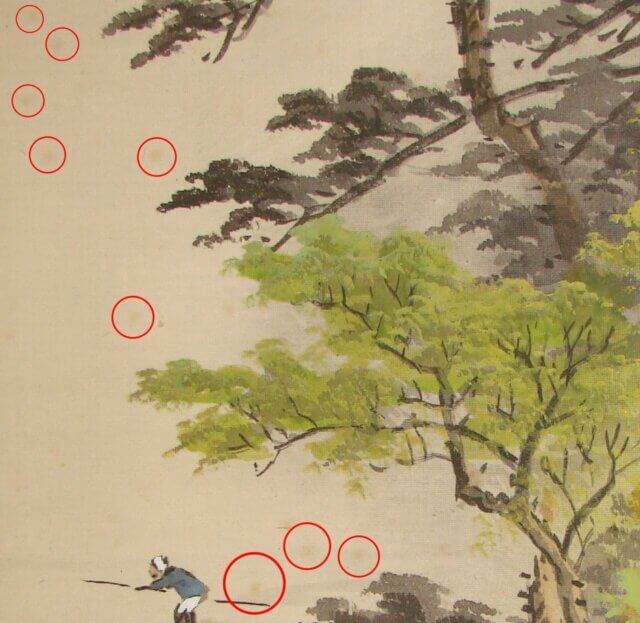Restoration Request for a Kakejiku from the U.K. | Stain Removal, Length Adjustment

Restoration Request for a Kakejiku from the U.K. | Stain Removal, Length Adjustment
We welcome international commissions in respect of kakejiku.
We are very grateful for our customers from over 40 countries who utilized our service.
What makes our profession pleasurable is that our work enables us to meet people from all walks of life and to hear the stories of their lives through their kakejiku.
Here is the story of a commission from a British customer, whom we had the opportunity of getting to know through the story of her kakajiku.
The kakejiku shown below is the one from the customer, a rather small landscape kakejiku at 30cm in width, 106cm in length.

The piece has developed tiny faint stains, although they are almost invisible in this photo.

The Consultation on the Request in Detail
The remounting was to carry out with the following procedures after a thorough consultation with the customer.
Stain Removal: To be executed as far as possible.
Mounting Style: Gyō-no-gyō
Finished Size: 24cm in width, 130-140cm in length
Fabric: See the picture below.
Restoration Process
The rough workflow of the remounting operations is as follows.
Disassembling the art piece – Removing the old fabric / Detaching the rod etc.
↓
Removing the old backing paper – Peeling off the old backing paper from the reverse of the artwork.
↓
Removing stains – Getting rid of stains with solution as far as we could.
↓
Remounting – Remounting the kakejiku with the fabric chosen by the customer.
Completion of the Restoration
Having gone through the lengthy restoration process, finally, the remounting of the kakejiku has been brought to completion.
According to the customer, the place for displaying the kakejiku limits the height of the art piece up to 130-140cm, and therefore, we adjusted the length of the fabric by gradually shortening it by request.
The bothersome stains are now hardly seen.
Voice of the Customer
The finished piece was sent to the U.K. in no time and we received feedback from the customer expressing her deep gratitude after reuniting with the art piece.
Dear Mr. Nomura
The scroll arrived this morning and it is perfect – we are absolutely thrilled with it!
Thank you so much and thank you to your team for all your hard work and expertise in restoring it – it looks fantastic. The drawing is now so clear and vibrant since all of the stains were removed. We are in awe of the skills that you must have to do this! It was very kind of you as well to replace the 地杆 at the bottom of the scroll – the effect is wonderful and the colors go together beautifully.
My grandmother and grandfather purchased this scroll when they lived in Kobe in the 1960s. They had a wonderful time and had many happy memories. it is lovely to be able to restore the scroll as a memory of them.
Best wishes and many thanks
Personally, I have an impression that foreigners have a wider range of expressions of gratitude than the Japanese do.
Also to my surprise, the grandparents of the customer used to live in Kōbe, the city we are based in. Apparently, they stayed there on business.
I would say there has been a wonderful coincidence here of a kakejiku purchased by the grandparents in Kōbe, that passed to the grandchildren after more than 60 years, was then returned to Kōbe to be restored by us, and was finally returned to the UK. We feel very privileged. We truly hope that the restored kakejiku will now be cherished once again by the grandchildren.
We are delighted to welcome international commissions, like the example above, for the restoration of kakejiku.
We offer a comprehensive restoration service for your kakejiku, tailored to whatever dimensions you require and to suit whatever materials, colours, and fabric decoration you wish, so please feel free to contact us if you would like to rejuvenate and restore your works of art. They will be safe in our hands and we would be delighted to be of service.



